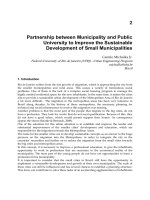separation and purification techniques in biotechnology
Bạn đang xem bản rút gọn của tài liệu. Xem và tải ngay bản đầy đủ của tài liệu tại đây (19.83 MB, 499 trang )
SEPARATION AND
PURIFICATION
TECHNIQUES
IN BIOTECHNOLOGY
Frederick J. Dechow
Reed & Carnrick Pharmaceuticals
Piscataway, New Jersey
I-J
nP
NOYES PUBLICATIONS
Park Ridge, New Jersey, U.S.A.
Copyright @I 1989 by Frederick J. Dechow
No part of this book may be reproduced or utilized in
any form or by any means, electronic or mechanical,
including photocopying, recording or by any informa-
tion storage and retrieval system, without permission
in writing from the Publisher.
Library of Congress Catalog Card Number: 88-34502
KEN: o-8155-1197-3
Printed in the United States
Published in the United States of America by
Noyes Publications
Mill Road, Park Ridge, New Jersey 07656
10987654321
Library of Congress Cataloging-in-Publication Data
Dechow, Frederick J.
Separation and purification techniques in
biotechnology.
Includes bibliographies and index.
1. Biomolecules Separation. 2. Biomolecules
Purification. 3. Biotechnology Technique. I. Title.
TP248.25.S47D43 1989 660.2’842 88.34502
ISBN 0-8155-l 197-3
Preface
Sorptive separation techniques are found in almost every product separation
or purification scheme treating fermentation or biochemical feedstreams. These
sorptive techniques include adsorption, ion exchange and liquid chromatography
on solid supports. The major objective of this book is to place these different
methods in perspective, relative to each other, so that selection of the appropri-
ate technique or combination of techniques may be readily made. While the
emphasis has been placed on laboratory evaluation techniques, the scale-up of
these techniques and their industrial applications; it is hoped that sufficient
theory has been provided so that the interested reader may use the references
to pursue the selectivity and kinetic considerations for sorptive procedures.
The first chapter provides a brief sketch of the nature of the biochemical
feedstream and all the processes which might be involved in isolating the de-
sired products from that feedstream.
Chapter 2 covers adsorptive separation, which is the oldest of the sorptive
techniques. While many people now regard adsorption as strictly for the removal
of unwanted impurities or color bodies, this chapter shows that there are many
applications where adsorption is useful in isolating biochemical products. The
theory of column processes developed in this chapter is also applicable to the
column operations for the sorptive processes described in the other chapters.
Ion exchange procedures are described in Chapter 3. This chapter builds
upon what was presented in Chapter 2 by demonstrating the effects of the
additional sorptive specificity associated with the exchange of ions. Operating
parameters and equipment developed for water treatment and metal recovery
applications have also been included since fermentation broths have character-
istics which may benefit from the use of resin-in-pulp, fluidized bed and the
other procedures presented.
V
vi Preface
Chapter 4, Column Chromatography Processes, covers the use of sorptive
materials to create an environment that allows the separate recovery of two or
more solutes. The biospecific recognition of a solute for a ligand attached to
the column material is covered in the last chapter on Affinity Chromatography.
It is my hope that this book will serve as a useful guide to the solution of
the practical problems associated with separating and purifying fermentation
and biotechnology products.
I would like to acknowledge the helpful suggestions of Henry C. Vogel,
the patience of George Narita and the support and understanding of my wife,
Joan Dechow. I also wish to recognize the assistance of Audrey Wildeck for
secretarial support and of Bart Alazio for preparing the illustrations.
April 1989 Frederick J. Dechow
NOTICE
To the best of the Publisher’s knowledge the informa-
tion contained in this publication is accurate; however,
the Publisher assumes no liability for errors or any con-
sequences arising from the use of the information con-
tained herein. Final determination of the suitability of
any information, procedure, or product for use con-
templated by any user, and the manner of that use, is
the sole responsibility of the user.
Mention of trade names or commercial products does
not constitute endorsement or recommendation for use
by the Publisher.
The book is intended for information only. The
reader is warned that caution must always be exercised
when dealing with hazardous, or potentially hazardous,
materials, and expert advice should be obtained at all
times when implementation is being considered.
Contents
1. INTRODUCTION. .l
1.1 Fermentation Broth. .l
1.2 Recovery Unit Operations. .4
1.2.1 Mechanical Operations .6
1.2.1.1 Filtration. .6
1.2.1.2 Centrifugation .9
1.2.1.3 Evaporation. .16
1.2.1.4 Crystallization .22
1.2.1.5 Drying. .29
1.2.2 Membrane Processes. .34
1.2.3 Solvent Extraction, .42
1.2.4 Electrophoresis and Electrodialysis .47
1.3 Recovery Processes .54
1.4 References. .60
2. ADSORPTION. .65
2.1 Introduction. .65
2.2 Adsorption Theory .66
2.2.1 Adsorption Isotherm .68
2.2.2 Adsorption Kinetics. .77
2.3 Types of Adsorbents .95
2.3.1 Carbon and Activated Charcoal .99
2.3.2 Silica Gels, AIuminas and Zeolites. 102
2.3.3 Organic Polymer Adsorbents 105
2.4 Laboratory Evaluation of Adsorbents 109
2.5 Adsorbent Operations 114
2.5.1 Pretreatment Operations. 114
2.5.2 Batch Operations. 116
2.5.3 Column Operations .117
vii
viii Contents
2.5.4 Regeneration Operations.
125
2.6 Process Considerations.
131
2.6.1 Design Factors
131
2.6.2 Pressure Drop
.134
2.6.3 Computer Design.
.136
2.7 Adsorption Applications.
.136
2.7.1 Decolorization
136
2.7.2 Antibiotics.
141
2.7.3 Enzymes
.144
2.7.4 Microorganism Adsorption
146
2.7.5 Organic Acids and Amines.
147
2.7.6 Vitamin Adsorption.
150
2.7.7 Miscellaneous Product Purifications
152
2.7.8 Ethanol Adsorption.
153
2.7.9 Adsorption as a Fermentation Aid
155
2.8 References.
.156
3. ION EXCHANGE
.163
3.1 Introduction.
.163
3.2 Theory
.164
3.2.1 Selectivity
.166
3.2.2 Kinetics
.179
3.3 Ion Exchange Materials and Their Properties.
193
3.3.1 Ion Exchange Matrix
194
3.3.2 Functional Groups.
198
3.3.3 Porosity and Surface Area.
201
3.3.4 Particle Density.
209
3.3.5 Particle Size
210
3.4 Laboratory Evaluation Resin.
211
3.5 Ion Exchange Processes
220
3.5.1 Process Categories
220
3.5.1.1 Demineraiization.
220
3.5.1.2 Conversion.
.220
3.5.1.3 Purification
221
3.5.1.4 Concentration.
221
3.5.2 Purification Procedures.
221
3.5.2.1 Purification of Strong Bases.
221
3.5.2.2 Purification of Strong Acids
222
3.5.2.3 Purification of Weak Bases
223
3.5.2.4 Purification of Weak Acids
224
3.5.3 Biopolymer-Resin Interactions.
225
3.6 Ion Exchange Operations
.228
3.6.1 Pretreatment
.229
3.6.2 Batch Operations.
.229
3.6.3 Column Operations
230
3,6,3.1
Fixed Bed Columns
230
3.6.3.2 Continuous Column Operations
234
3.6.3.3 Fiuidized Column Operations
236
Contents ix
3.6.4 Elution/Regeneration.
244
3.6.5 Backwashing.
.246
3.7 Process Considerations.
248
3.7.1 Design Factors
248
3.7.1.1 Scaling-Up Fixed Bed Operations
248
3.7.1.2 Comparison of Packed and Fluidized Beds
253
3.7.1.3 Pressure Drop.
255
3.7.2 Computer Calculations.
256
3.7.3 Economic Analysis
260
3.7.4 Ion Exchange Resin Limitations.
262
3.8 Biotechnology Applications.
267
3.8.1 Amino Acid Purification.
268
3.8.2 Antibiotics.
274
3.8.3 Pharmaceuticals and Organic Acids.
286
3.8.4 Protein Purification
288
3.8.5 Sugar Stream Processing
295
3.8.5.1 Decolorization
295
3.8.5.2 Demineralization.
298
3.8.6 Vitamins
.303
3.8.7 Wine Treatment
.305
3.8.8 Enzyme Immobilization
307
3.8.9 Catalytic Applications
310
Appendix.
.312
3.9 References.
.320
4. COLUMN CHROMATOGRAPHY PROCESSES
.333
4.1 Introduction.
.333
4.2 Classifications of Chromatography
335
4.2.1 Chromatographic Methods
.335
4.2.2 Types of Chromatographic Separations
337
4.2.3 Chromatographic Processing Techniques
342
4.3 Chromatographic Materials
343
4.4 Theory
.348
4.4.1 Theoretical Plate Height.
350
4.4.2 Zone Spreading.
.352
4.4.3 Resolution.
353
4.5 Laboratory Techniques.
.366
4.6 Scale-Up Procedures.
370
4.7 Industrial Systems.
.376
4.8 Chromatography Applications.
.385
4.8.1 Amino Acid Separation
386
4.8.2 Antibiotics.
388
4.8.3 Glucose-Fructose Separation
388
4.8.4 Glycerol Purification
390
4.8.5 Oligosaccharide Removal
391
4.8.6 Peptides and Proteins.
392
4.8.7 Polyhydric Alcohol Separation.
400
4.8.8 Regenerant Recovery.
.400
x Contents
4.8.9 Sugar from Molasses.
402
4.9 References.
.405
5. AFFINITY CHROMATOGRAPHY.
.416
5.1 Introduction.
.416
5.2 Theory of Affinity Chromatography.
418
5.2.1 Equilibrium and Binding Selectivity
.419
5.2.2 Kinetics of Affinity Purification.
.424
5.3 Affinity Chromatography Materials.
.430
5.3.1 Supports.
.430
5.3.1.1 Agarose.
.431
5.3.1.2 Polyacrylamide Gels.
435
5.3.1.3 Controlled Pore Glass.
436
5.3.2 Spacers.
.438
5.3.3 Llgands
.439
5.4 Laboratory Practices
.443
5.4.1 Selecting a Ligand
.443
5.4.2 Preparing the Support-Ligand
.446
5.4.3 Ligate Adsorption
.449
5.4.4 Ligate Elution.
.450
5.5 Scale-Up of Laboratory Procedures.
,453
5.6 Affinity Chromatography Operations
.456
5.6.1 Batch Operations.
.456
5.6.2 Column Operations
.458
5.6.3 Affinity Purification with Membrane Operations.
.462
5.6.4 Ligand Costs.
.466
5.7 Affinity Chromatography Applications
467
5.7.1 Protein Purification
.467
5.7.2 Interferon Purification.
.472
5.7.3 Receptor-Binding Affinity Chromatography.
.473
5.7.4 Immuno Affinity Chromatography.
.476
5.7.5 Cell Separation by Affinity Chromatography
.476
5.8 References.
.478
INDEX 485
1
Introduction
The recovery of products
from fermentation or
biochemical processes has been cited (1) as the last hurdle to
be overcome in bringing biotechnology from the laboratory to
commercial status.
This text will attempt to describe how
adsorptive materials,
ion
exchange resins,
column
chromatography and affinity chromatography can be utilized
in these recovery and purification operations. This chapter
will examine the nature of the fermentation broth and will
serve to put these recovery operations in perspective with
other purification techniques not covered by this text.
It is
essential to understand the relative advantages of each and
their interrelationships since most purifications will require
combinations of different techniques.
1 .l FERMENTATION BROTH
The fermentation broth is the combination of insoluble,
gelatinous biomass, the nutrient fluid, and the soluble
metabolites resulting from the fermentation operation. When
the fermentation is carried out without any form of inert
support for the biomass, the limit of fluidity for stirring or
aeration is approximately 3 to 7% WV dry weight of biomass.
Physically, biomass is a compressible, gelatinous solid with
surface layers of polysaccharide material
which make it
cohere and adhere. Downstream processing, therefore, has to
deal with a viscous, highly non-Newtonian slurry as its
feedstock.
1
2
Separation and Purification Techniques in Biotechnology
For example,
a bacterial fermentation for single cell
protein will produce a broth of 3% WV in which the slurry is
about 60% (by volume) wet biomass and 40% interparticle
fluid. When biomass supports are used, somewhat higher
operating biomass concentrations are possible and, in waste
disposal fermentations, the concentration has been raised
from 2 to 5 g/liter to 10 to 40 g/liter.
Compared with the feed streams to recovery processes
in conventional chemical processing, fermentation broths are
very dilute aqueous systems (see Table 1.1).
Therefore, it
will be particularly important to avoid energy intensive
thermal operations and to select processes which give large
concentration increases in the first stage or stages.
Table 1.1: Typical Product Concentrations Leaving Fermenters
Product
Grams per Liter
Antibiotics (e.g., Penicillin G)
10-30
Enzyme protein (serum protease)
2-5
Ethanol
70-120
Lipids
10-30
Organic acids (citric, lactic)
40-100
Riboflavin
10-15
Vitamin B12
0.02
The fluid volume in microbiological processes must be
reduced by at least an order of magnitude between the broth
and the final fluid stages of the recovery processes and, in
some cases,
by very much more. For vitamin B- 12 the
reduction
ratio is over 1OOO:l.
Consequently, the plant
design and the range of acceptable unit operations changes
significantly as the fluid progresses from the broth handling
stages to the final isolation stage.
Many fermentation broths are unstable.
Once any broth
leaves the controlled, aseptic environment of the fermenter,
it is exposed to a drastic change of conditions.
An actively
growing biomass from an aerated culture will be suddenly
deprived of oxygen and
will experience a rapidly falling
concentration of nutrients.
This frequently produces rapid
changes in
physical properties, leading to destruction of
desired product.
Lipids may be consumed as an alternative
energy source
for continuing metabolic activity.
Enzymes
may be
destroyed by
proteases
released from
the
deteriorating cells.
The broth also becomes susceptible to
Introduction 3
contamination from foreign organisms which can have the
same effects.
Similar problems can occur if the recovery operations of
a batch fermentation are delayed.
The problems can be
reduced by chilling to around 5OC.
This is commonly done
for enzymes
and other relatively
small output processes.
However, this is to be avoided, if possible, with larger fluid
volumes
since
chilling
from a typical
fermentation
temperature of 35OC to 5OC requires refrigeration energy of
about 40
kWh/m3 of broth and
considerable
capital
expenditure.
The time for appreciable product loss to occur
can be as little as 20 minutes at fermentation temperatures.
The necessary and
practical recovery
operations
employed
and the order in
which they are
used in
downstream processing can be reduced to deceptively simple
looking recovery sequences.
Figure 1.1 (2) shows a schematic
of the recovery sequence and the techniques associated with
each process.
Producl
in CIIII.
Product in broth
or .queous phase
Sedimentation
Filtration
from whole cdls
solvsnf/d~lrrgent
rend&-q membranes,
rtc, “leaky’!
Solvent extraction
Ion exchanpe
Adsorption
Gel filfrstion
Affinity method9
Distillation
Membranes
Electrophoresir
Differential freezing
Evaporation
Membrsner
Pmcipitalion
Adsorption. ion exchange, clf%ily. erc
Frocra.ThDwing-cryslalliralion
Figure 1.1.
Schematic of the processes which may be
involved in the separation and fractionation of fermentation
products (Reference 2).
4 Separation and Purification Techniques in Biotechnology
If the desired product is extracellular, it is only
necessary to filter the biomass from the broth and isolate
the product from the fluid. If a product is intracellular, a
cell disruption step must first be employed. If the product is
also water soluble, this disruption should be performed while
the biomass is still in a slurry form.
The chemical stability
and solubility of the product will dictate the most suitable
recovery techniques. Most microbiological products have
limited chemical stability.
This puts severe restrictions on
the temperatures, the reactants, and pH levels which can be
used.
An
important consideration in determining the
appropriateness of a recovery technique is the actual purity
requirement for the product.
Many products, such as
enzymes and vaccines, will not need to be isolated as pure
compounds. An appropriate product in these cases would be
a complex mixture having the desired properties. However,
removal of specific materials,
such as pyrogens in injectable
medicinals, would be necessary.
The
major recovery difficulties arise when it is
necessary to separate specific
compounds
from
other
chemically and physically similar materials. The isolation of
enhanced purity enzyme protein from other protein requires
highly specific physico-chemical effects to be used. Today it
is the exception rather than the norm for the separated
compounds to be that similar.
Normally there is a range of
alternative recovery techniques and a selection can be made
on the basis of cost, familiarity, and reliability criteria.
1.2 RECOVERY UNIT OPERATIONS
The various methods for treating the fermentation broth
can be divided into mechanical or chemical unit operations.
Table 1.2 lists the processes normally included in each
category.
Filtration
and centrifugation are unit operations in
which the suspended solids are separated from the fluid
phase. Drying is the removal of moisture or solvent from
solid particles, while evaporation is the removal of moisture
or solvent from a solution. In crystallization, the conditions
of a solution are adjusted to change the solubility of one of
Introduction 5
Table 1.2: Separation and Recovery Techniques
Mechanical
Filtration
Centrifugation
Evaporation
Crystallization
Drying
Reverse osmosis
Ultrafiltration
Chemical
Adsorption
Ion exchange
Column chromatography
Affinity chromatography
Solvent extraction
Electrophoresis
Electrodialysis
the dissolved compounds so that it leaves the solution as a
solid.
Microfiltration, ultrafiltration, and reverse osmosis are
membrane processes in which
separation is
based on
differences in ability to flow through a thin barrier that
separates two fluids. Microfiltration is a hydraulically driven
process using a membrane with a pore size in the 100 to
3000 A range.
For ultrafiltration, the pore size is from 10
to 125 A, while for reverse osmosis, the pore size is from 3
to lo A.
Adsorption,
ion exchange,
column chromatography, and
affinity chromatography
can be
grouped as
recovery
techniques in
which
the
removed compound or
solute
establishes an equilibrium between sites on a solid phase
material and the solution.
In adsorption, the removed species
is bonded to the solid phase material by polarity or weak
chemical bonds.
Ion exchange recovers material by the
interchange of ions between the liquid and solid phases.
Column chromatography may use adsorptive, ion exchange or
molecular sieve materials to separate solutes which are first
loaded onto a column of the separation material and then
eluted in such a manner that the individual solutes are
collected in separate fractions.
In affinity chromatography,
the removed species is bound with a high level of selectivity
to ligands covalently attached to a solid matrix.
In solvent extraction, the removed compound establishes
an
equilibrium
distribution between immiscible solvents,
usually water and an organic liquid.
Electrophoresis and
electrodialysis are
separation
techniques that separate charged molecules or ions using an
6 Separation and Purification Techniques in Biotechnology
electric field. Electrophoresis separates charged components
by accentuating small differences in ionic mobility in an
electric field using a moving carrier fluid. Electrodialysis
concentrates components on the basis
of electromigration
through ionic membranes.
1.2.1 Mechanical Operations
1.2.1.1
Filtration: Filtration is typically the first step
in the isolation of any product from the fermentation broth.
This process separates the biomass cells, the cell debris, and
any precipitates from the broth fluid. The mathematical
representation of the
incremental
time dt to filter an
additional incremental volume dV after a volume V has been
filtered is given by:
dt/dV = a t bV
(1.1)
The right side of the equation contains two components,
a and b.
The a term is r)r,/AP and the b term, which
depends on V, is equal to r]r,/A2PW, where n is the liquid
viscosity, rs is
the specific cake resistance of the filter
material,
A is the filter area, P is the constant applied
pressure difference, rC
is the specific cake resistance, and W
is the cake dry weight per unit volume of filtrate.
Normally
the resistance of the filter material term includes the
resistance contribution
of any filtration aid, pipes, and
valves.
According to this equation, the resistance to filtration
is due initially to only the constant term a. In theory, as
filtration proceeds and the biomass cake becomes thicker, the
resistance would be expected to increase linearly according to
the b term with this dependence on V. Although many
practical considerations must be taken into account when
applying this equation, its simplicity, the complexity of a
more exact description, and the uniqueness of many industrial
applications result in Equation 1 .l being the most useful
filtration representation.
The specific practical limitations that
must be
considered are the blockage or blinding of the filter, the
compressibility of the biomass cake, and the variable pore
structure of the cake. Blinding of the filter may be
prevented by starting the filtration at a low hydraulic
pressure by partially by-passing the pump.
This will avoid
Introduction 7
driving the first solids into the filter support.
The biomass
cake’s compressibility will usually be proportional to the
applied hydraulic pressure up to a certain pressure.
Beyond
that pressure,
the cake will collapse to a new compressed
form so that throughput is
reduced with the incremental
pressure increase.
Table 1.3 shows filtration design and operation for
different fermentation broths.
In two of the cases noted in
Table 1.3 a precoat was used.
The filter will often be
precoated with a filtration aid such as diatomaceous earth to
reduce blinding of the filter and to increase filtration rates.
The filtration aid might be added to the broth but then the
quantity of filtration aid required is more than double the
precoat amount (3).
Table 1.3: Representative Design and Operating Results for
Fermentation Broth (Vacuum 0.68-0.85 Bar)
Bacillus
Streptomyces
Penicillium
licheniformis
ery threus chrysogenum
filter type Vacuum precoat
Vacuum drum Vacuum drum or
precoat
Design filtration
rate (9_/hr-m2)
160-320 400
1,400-1,800
Solids in slurry
(wt %) 8
25
2-8
Cycle time
(min/rev)
0.5
3
3
Filter medium Precoat Nylon
Polypropylene
Cake discharge
mechanism Precoat String
String or precoat
The equipment in this operation can be as simple as an
enlarged laboratory vacuum filter to more elaborate rotary
vacuum filters.
These latter filters essentially consist of a
hollow segmented drum covered with a filter cloth.
The
drum rotates in a bath of the broth to be filtered while a
vacuum inside the drum sucks liquid through the filter cloth,
forming a coating of solids on the outside of the drum.
Provisions are usually made to wash the filter cake during
filtration followed by removing the solid from the cloth.
Instead of vacuum, pressure can be used to drive the fluid
through a filter cake.
Plate and frame pressure filters
consist of wire or perforated metal frames which act as the
mechanical support for the filter medium which can be fine
8 Separation and Purification Techniques in Biotechnology
wire mesh, woven cloth or cellulosic pads. With deep frame
patterns, these filters can be used with diatomaceous pre-
coats.
Example 1 .l
Figure 1.2 shows the influence of pH on the filtration
rate of S. griseus broth, 1.5 centipoise, using 100 cm2 cotton
cloth filter, diatomaceous earth filter aid and a constant
pressure difference of 2 bar (4). What size of filter is
needed to filter 1000 L of fermentation broth at pH 3.8 in 15
minutes?
Figure 1.2.
The filtration time (t) divided by the volume of
filtrate collected is plotted against the volume of filtrate
collected for different pH values (Reference 4).
For the sake of simplicity, it is assumed that the filter
:ake is incompressible so that Equation 1.1 can be integrated
10 give:
t
nrS 1
( )
1
v =
P A
+
arc V
( 1
2PW ,
x2
(1.2)
Introduction 9
The slope and intercept for the pH 3.8 curve can be used to
obtain the values for rs and r,/W from the information
given. Using the data points (300, 0.7) and (600, 1.82), rs =
-55.73 and r,/W = 99.55.
Equation 1.2 is a quadratic equation in (l/A), so that:
1
( )
_(y t &gyy
A =
nrcV
(1.3)
PW
With V =
1000 L and t = 900 set, this equations gives l/A =
5.5 x 10w6, or A = 18.18 m2,
The slight curvature of the experimental lines in Figure
1.2 indicates that
the
cake has some
degree of
compressibility. This is to be expected for cakes formed
from fermentation cells.
As the volumes, and therefore
required
times,
for the same filter area increase, the
curvature will become more pronounced. While decreasing
the pH would speed up the filtration, one must be careful so
that the product is not adversely affected.
Several reviews and texts (3, 5-10) exist which should
be consulted for additional information on this integral part
of any fermentation broth recovery system. A list of
industrial filtration equipment suppliers is given in Table 1.4.
1.2.1.2 Centrifugation:
Centrifugation, although widely
used for cell recovery, is not nearly as
ubiquitous as
filtration.
This process enhances the gravitational settling of
the suspended solids in the fermentation broth.
The
mathematical representation for the centrifugation process is
given by:
18n
St2
cp
=
.
d* (cc
- (1.4)
- PL) g
2
w rV
In this equation Cp is the time required for complete
particle removal, d is the particle diameter, ps is the particle
density, pL is the fluid density, r7 is the fluid viscosity, s is
10 Separation and Purification Techniques in Biotechnology
Table 1.4: Industrial Filtration Equipment Suppliers
Company
Location
Allied Filtration Co.
Kingsley, PA
Avery Filter Co.
Westwood, NJ
Bird Machine Company
South Walpole, MA
Carl C. Brimmekamp & Co.
Stamford, CT
Denver Equipment Company
Colorado Springs, CO
Dorr-Oliver, Inc.
Stamford, CT
EIMCO (Div. of Envirotech)
Salt Lake City, UT
B C Hoesch Industries
Wharton, NJ
Inlay, Inc.
Califon, NJ
Komline-Sanderson, Inc.
Peapack, NJ
Lenser America, Inc.
Lakewood, NJ
Peterson Filters, Inc.
Salt Lake City, UT
R & R Filtration Systems
Marietta, GA
Serfilco,‘Ltd.
Glenview, IL
Sparkler Filters, Inc.
Conroe, TX
D.R. Sperry & Co.
North Aurora, IL
the thickness of the liquid layer in the centrifuge, w is the
angular velocity, r is the rotation radius, V is the total
volume of liquid in the centrifuge and g is the gravitational
constant.
The right-hand side of the equation is shown divided
into two terms. The first corresponds to the terminal
velocity of the particle with diameter d under the force of
gravity.
This term is solely concerned with properties of the
fluid and suspended particles.
The second component is
concerned only with fixed characteristics of the centrifuge
operating at a fixed speed, w.
This term is normally written
as sigma,
C, the equivalent area of sedimentation centrifuge.
If it can be assumed that the liquid layer is thin and that
there are
no interactions between solid particles,
then C
provides a basis for comparing different sizes and types of
centrifuges (11).
The equation points out that, with respect to the feed
material,
centrifugation is
enhanced by large particle
diameter, a large difference in density between particles and
the fluid, and low viscosity.
Likewise, separation is favored
by centrifugation equipment which is operated at a high
angular speed, has a large centrifuge radius, and can hold a
large volume of liquid while at the same time has a thin
liquid sedimentation layer.
Introduction 11
Example 1.2
For a fermentation broth that is a dilute suspension of
cells in an essentially aqueous solution, the diameter of the
cells is 5 microns.
They have a density of 1.001 g/cc.
The
viscosity of the broth is 2 centipoise.
If 50 ml of the broth
is placed in a centrifuge tube whose bottom in 10 cm from
the rotation axis,
what is the time required for complete
separation of the cells from the liquid supernatant at 3000
rpm?
If one assumes that the fermentation broth contains 5%
(by volume) suspended cells and that the cross-sectional area
of the centrifuge is 5 cm2,
the liquid layer through which
the cells must travel is a maximum of 9.5 cm. Therefore,
using Equation 1.4, the time for complete removal of the
suspended cells is 304 sec.
The difficulties associated with centrifugation
become
apparent when the typical fermentation broth characteristics
are
considered in the light of
these centrifugation
enhancement factors.
The biomass particles, typically, are of
very small size and of low density.
The fluid can be highly
viscous and, depending on the amount of dissolved solids, of
density comparable to the biomass.
There are physical
limitations on the equipment as well.
Attempts to increase
capacity by increasing the centrifuge radius soon reach the
point where mechanical stress and safe operation place a
limit.
The increase in bowl capacity and the continuous
flowing through of fluids restrict the safe angular velocity.
When solids are discharged during operation, the inherent
imbalance this causes will further restrict the maximum safe
angular velocity.
Within these limitations,
several centrifuge equipment
designs have been developed or adapted for the fermentation
industry.
The centrifuges utilized for fermentation product
recovery fall into two basic types, the perforated bowl or
basket type and the solid bowl high speed types. The basket
centrifuge (Figure 1.3a) normally is used with a filter bag of
nylon,
terylene,
or cotton.
The feed is added continually.
When the bowl is filled with the biomass cake, fresh washing
liquid can be added to displace the residual broth fluid
retained in the cake.
This has many of the characteristics
of filtration but has considerably faster throughput.
12
Separation and Purification Techniques in Biotechnology
FEED
EFFLUENT
POROUS LINER
FILTER CAKE
PERFORATED FRAME
>
a
rl
FEED
b
m EFFLUENT
FILTER CAKE
Figure 1.3.
Centrifuges. (a) Perforated bowl or basket type
centrifuge. (b) Tubular bowl centrifuge.
(c) Multi chamber
solid bowl centrifuge. (d) Nozzle disk centrifuge.
(e) De-
sludger or intermittent
discharge
centrifuge.
(f) Scroll
centrifuges.
Introduction 13
FEED
SOL IDS
EFFLUENT
CG
SOLIDS
d
Figure 1.3. (continued)
14 Separation and Purification Techniques in Biotechnology
INTERMITTENT
e
EFFL
FEED
Figure 1.3. (continued)
Introduction 15
Solid bowl centrifuges are available in five basic types.
The first type
is called tubular bowl (Figure
1.3b) and
operates like a batch laboratory centrifuge.
A continuous
feed of material passes through the machine. As soon as the
bowl is full of the biomass cake, the centrifuge is stopped,
stripped down, the cake removed, the machine cleaned and
the sequence repeated.
Typical batch size is about 4 kg wet
weight.
A variation on this type is the multichamber
centrifuge (Figure 1.3~) which allows three or more time the
capacity of the tubular bowl.
However, the disassembly and
cleaning of this centrifuge is more difficult.
The third and fourth types operate continuously since
the solids are automatically removed from the bowl.
The one
is
called a nozzle disk centrifuge (Figure 1.3d).
This
centrifuge discharges a continuous stream of concentrated
solid-slurry.
The other disk centrifuge is termed a de-
sludger (Figure 1.3e).
This centrifuge has an intermittent
discharge of solids with lower water content than the nozzle
centrifuge.
The final type is called a scroll centrifuge (Figure 1.3f).
This centrifuge uses a screw within a rotating bowl to allow
continuous removal of the solid and the liquid portions.
This
type of centrifuge is recommended when the solids are so
coarse that they would blind the discharge systems of the
disk type of continuous centrifuges.
Table 1.5 shows the characteristics of the different
types of centrifuges. There is a specific particle size range,
maximum centrifugal force and fluid capacity for each type
of centrifuge. Reviews and texts on centrifugation (1 l-15)
can be used for additional information. A list of industrial
centrifugation equipment suppliers is given in Table 1.6.
Table 1.5 : Characteristics of Different Types of Centrifuges
Type
Basket
Tubular bowl
Multichamber
Disk, nozzle
De-sludger
Scroll
Particle Size Centrifugal Force
(pm)
(a’r/g)
lo-8,000
1,800
0.01-100
16,000
0.01-100 6,000
0.1-100
9,000
0.1-100
6,000
2-3,000
3,000
Capacity
(Q/min)
300”
80”
250*
4,000
1,000
1,150
*With interruptions for removal of solids.
16 Separation and Purification Techniques in Biotechnology
Table 1.6: Industrial Centrifuge Manufacturers
Company
Location
Alfa Lava& Inc.
Fort Lee, NJ
Amtek, Inc.
El Cajon, CA
Baker Perkins, Inc.
Saginaw, MI
Barrett Centrifugals
Worcester, MA
Bird Machine Company
South Walpole, MA
Centrico, Inc.
Northvale, NJ
Clinton Centrifuge, Inc.
Hatboro, PA
Commercial Filters
Lebanon, IN
Dorr-Oliver, Inc. Stamford, CT
Heinkel Filtering Systems
South Norwalk, CT
Krauss Filtering Systems, Inc.
Charlotte, NC
IEC Division, Damon Corp.
Needham, MA
Pennwalt Corp., Stokes Division
Warminster, PA
Quality Solids Separation Co.
Houston, TX
Robatel, Inc.
Pittsfield, MA
Sanborn Associates, Inc.
Wrentham, MA
Tema Systems, Inc.
Cincinnati, OH
Western States Machine Company
Hamilton, OH
1.2.1.3 Evaporation: Evaporation is the concentration of
a feed stream by the removal of the solvent through
vaporization of the solvent.
This process is distinguished
from distillation in that the vapor components are not
separately collected in evaporation.
Many fermentation fluids are dilute aqueous streams
which require the evaporation of large amounts of water.
This
requirement is complicated by many fermentation
products being damaged or destroyed if exposed to too great
a temperature over an extended period of time.
Highly
efficient evaporators with short residence times are required
for evaporation of these heat sensitive products.
The efficiency of an evaporator is determined by its
ability to transfer heat, to separate liquid from vapor and its
energy consumption per unit of solvent evaporated.
Heat transfer rates can be treated with conventional
heat transfer calculations (16) if the evaporator has an
outside heating element where the solution or slurry is
pumped through the tubes.
Under steady state conditions of
flow rate,
temperature, pressure and composition, the energy
transferred across a heat exchanger or evaporator surface is
given by:



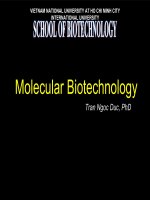
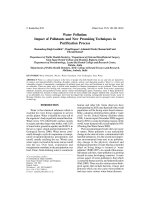
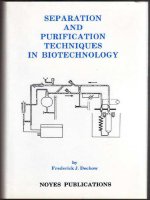
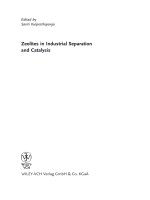
![computer techniques and comput. mthds. in biomechanics [vol 1] - c. leondes (crc, 2001)](https://media.store123doc.com/images/document/14/y/ob/medium_obk1399890599.jpg)

